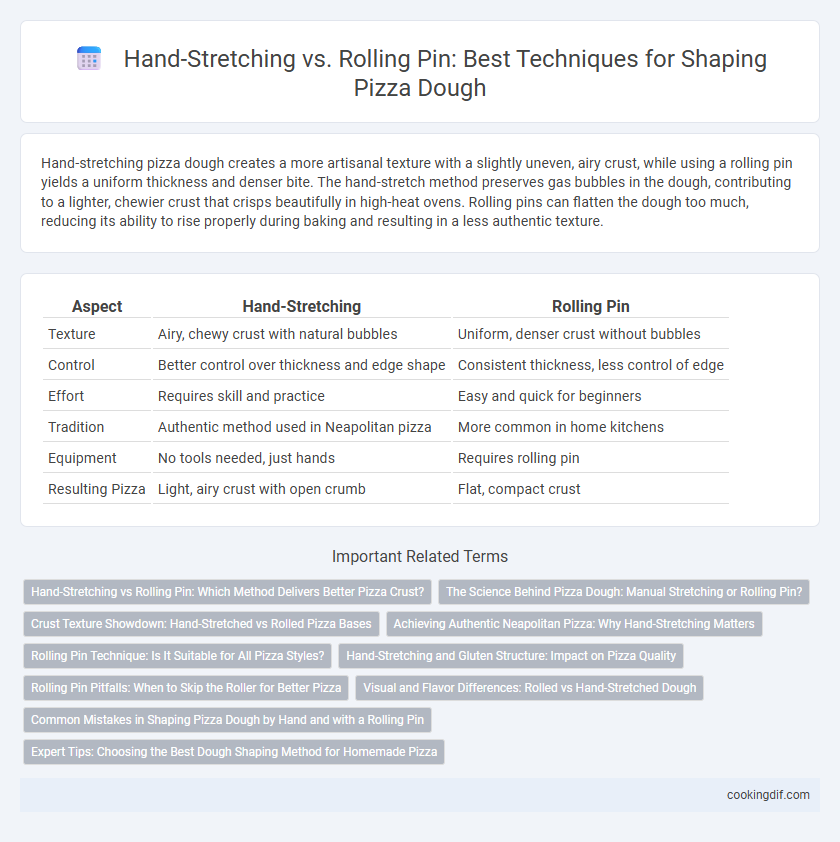Hand-stretching pizza dough creates a more artisanal texture with a slightly uneven, airy crust, while using a rolling pin yields a uniform thickness and denser bite. The hand-stretch method preserves gas bubbles in the dough, contributing to a lighter, chewier crust that crisps beautifully in high-heat ovens. Rolling pins can flatten the dough too much, reducing its ability to rise properly during baking and resulting in a less authentic texture.
Table of Comparison
| Aspect | Hand-Stretching | Rolling Pin |
|---|---|---|
| Texture | Airy, chewy crust with natural bubbles | Uniform, denser crust without bubbles |
| Control | Better control over thickness and edge shape | Consistent thickness, less control of edge |
| Effort | Requires skill and practice | Easy and quick for beginners |
| Tradition | Authentic method used in Neapolitan pizza | More common in home kitchens |
| Equipment | No tools needed, just hands | Requires rolling pin |
| Resulting Pizza | Light, airy crust with open crumb | Flat, compact crust |
Hand-Stretching vs Rolling Pin: Which Method Delivers Better Pizza Crust?
Hand-stretching pizza dough preserves the gluten structure, resulting in a chewier, airier crust with a more complex texture. Using a rolling pin can compress the dough, leading to a denser, less airy pizza base that lacks the characteristic lightness of traditional Neapolitan-style crusts. For optimal crust quality, hand-stretching maintains dough integrity and enhances oven spring, producing superior texture and flavor.
The Science Behind Pizza Dough: Manual Stretching or Rolling Pin?
Hand-stretching pizza dough preserves the gas bubbles formed during fermentation, resulting in a lighter, airier crust with better texture due to minimal gluten disruption. Using a rolling pin compresses the dough, driving out these gas bubbles and producing a denser, less chewy crust by breaking down gluten strands more aggressively. The choice between manual stretching and rolling pin use significantly impacts dough elasticity, crust rise, and flavor development, rooted in the science of gluten network integrity and gas retention.
Crust Texture Showdown: Hand-Stretched vs Rolled Pizza Bases
Hand-stretched pizza dough creates an airier, chewier crust with uneven thickness that enhances crispiness and a rustic texture. Rolled pizza bases produce a uniformly thin crust that is denser and crispier, ideal for thin-crust styles like Neapolitan and New York pizzas. The choice between hand-stretching and rolling directly impacts the final crust texture, influencing chewiness, texture complexity, and overall mouthfeel.
Achieving Authentic Neapolitan Pizza: Why Hand-Stretching Matters
Hand-stretching dough preserves the delicate gluten structure essential for achieving the airy, tender crust characteristic of authentic Neapolitan pizza. Rolling pins can compress the dough, leading to a denser texture that lacks the signature lightness and charred bubbles of traditional pizzas cooked in wood-fired ovens. Mastering hand-stretching ensures the dough maintains its elasticity and achieves the perfect balance of chewiness and crispiness intrinsic to Neapolitan style.
Rolling Pin Technique: Is It Suitable for All Pizza Styles?
The rolling pin technique compresses dough evenly, making it ideal for thin-crust and cracker-style pizzas that require uniform thickness. This method can limit air retention, resulting in a denser crust less suitable for Neapolitan or artisan styles that rely on hand-stretched dough's elasticity and bubbles. Ultimately, the rolling pin works best for pizzas demanding precise thickness and a crisp bite rather than airy, chewy textures.
Hand-Stretching and Gluten Structure: Impact on Pizza Quality
Hand-stretching pizza dough preserves the gluten structure by gently elongating the gluten strands, resulting in a light, airy crust with enhanced chewiness and elasticity. This method reduces the risk of overworking the dough, which can occur with a rolling pin, ensuring optimal gas retention for better rise and texture. Maintaining intact gluten networks through hand-stretching significantly improves the overall quality and mouthfeel of the pizza crust.
Rolling Pin Pitfalls: When to Skip the Roller for Better Pizza
Using a rolling pin for pizza dough can compress the air bubbles essential for a light, airy crust, resulting in a denser, less flavorful pizza. Hand-stretching preserves the dough's natural elasticity and allows for better control over thickness, creating a more authentic texture. Skip the rolling pin when aiming for traditional Neapolitan or artisan-style pizzas that require delicate, thin, and bubbly crusts.
Visual and Flavor Differences: Rolled vs Hand-Stretched Dough
Hand-stretched pizza dough offers a rustic, uneven texture that creates air pockets for a lighter, crispier crust, while rolled dough tends to produce a uniformly thin and denser base with fewer bubbles. Visually, hand-stretched crusts display charred, blistered edges characteristic of artisanal pizzas, whereas rolled dough appears smooth and consistent in thickness. Flavor-wise, the hand-stretching technique preserves the dough's natural fermentation nuances, enhancing the overall chewiness and depth compared to the slightly tougher texture of rolled dough.
Common Mistakes in Shaping Pizza Dough by Hand and with a Rolling Pin
Common mistakes in shaping pizza dough by hand include uneven stretching, which can cause thin spots and tears, and using excessive force that deflates the dough's air pockets, reducing its lightness. When using a rolling pin, over-rolling can result in a dense, tough crust by compressing the dough too much, and failing to allow the dough to rest often leads to excessive elasticity, making it difficult to achieve a smooth shape. Proper technique involves gentle, even pressure with hands to preserve dough structure or minimal rolling pin use combined with adequate resting periods to maintain optimal texture.
Expert Tips: Choosing the Best Dough Shaping Method for Homemade Pizza
Hand-stretching pizza dough preserves the gluten structure, creating a light, airy crust with a chewy texture, favored by many professional pizzaiolos. Using a rolling pin compresses the dough, which can result in a denser, less flavorful base, but ensures uniform thickness and ease of shaping, ideal for thinner, crispier pizzas. Expert pizzamakers recommend hand-stretching for Neapolitan-style pizzas to maintain authenticity, while rolling pins suit recipes requiring precise, even crusts like New York-style slices.
Hand-stretch vs rolling pin for shaping Infographic

 cookingdif.com
cookingdif.com